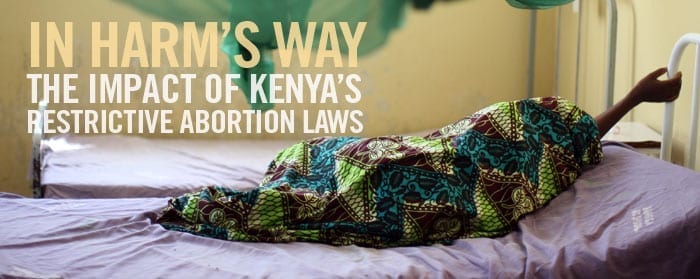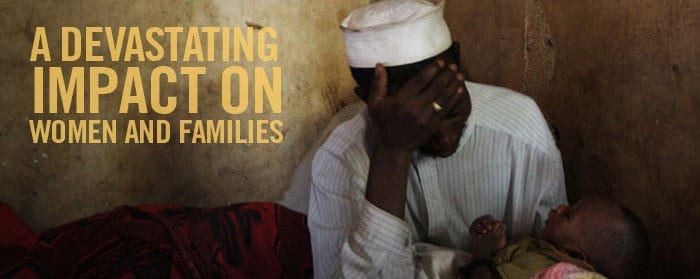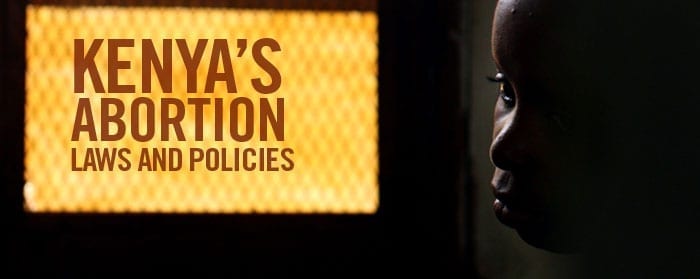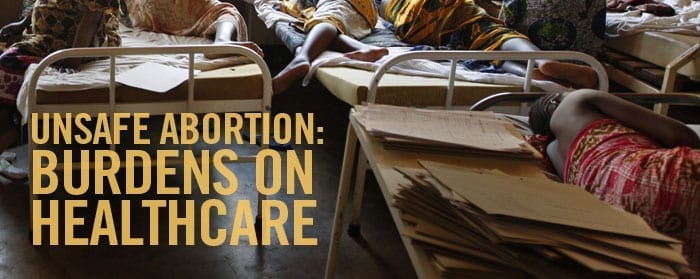In Harm’s Way: The Impact of Kenya’s Restrictive Abortion Law
Every year, at least 2,600 women die from unsafe abortion in Kenya, 21,000 more women are hospitalized annually with complications from incomplete and unsafe abortion, whether spontaneous or induced. As grim as these numbers are, they do not capture the number of women killed or disabled by unsafe abortions who never visit a health facility or whose cause of death is not recorded.
Sarah’s Story
Sarah was 14 years old when she died from complications from an unsafe abortion. She lived in a one room shack in the heart of Kibera — Kenya’s largest informal settlement — with her mother, four siblings and two nieces. Her father had died of AIDS and TB. Her mother, Evelyne, is HIV-positive and has permanent limited mobility due to spinal TB.
In order to earn money to feed her family, Sarah was forced to leave school at age 13. When she couldn’t find work washing clothes she would have sex with men for money. She would earn 100 shillings [less than $2.00] from these encounters to buy food for the family.
When Sarah became pregnant, a woman in Kibera advised her to get an abortion. Sarah procured an unsafe abortion from the woman’s friend, and soon developed a dangerous, life-threatening infection which left her in great pain and bed-ridden for a month. The cost of emergency healthcare and the fear of arrest kept her from going to a hospital. Sarah and her mother were afraid to talk to anyone about how sick she was because of the risk of arrest and the fear of community condemnation.
Sarah died at home on June 29, 2009. Her family now goes for days without food and survives on hand-outs from neighbors in Kibera [1].
[1] Story from personal interview with Sarah’s mother conducted by the Center for Reproductive Rights on July 11, 2009 in Kibera.
The Report
Unsafe abortion claims the lives of thousands of Kenyan women each year. Their deaths are entirely — and easily — preventable. Yet the Kenyan government has done little to address the problem.
Studies have long demonstrated the correlation between a country’s restrictive abortion law and high rates of maternal mortality. Where access to safe and legal abortion is limited, women resort to unsafe abortion, with devastating consequences for their health, lives, and families. This report documents these consequences in Kenya, highlighting how the country’s restrictive legal and policy regime, coupled with the Kenyan government’s failure to effectively address the root causes leading to unwanted pregnancies, leaves women squarely in harm’s way.
Background and Methodology >, Grace’s Story: Trapped by Poverty >, Rosemary’s Story: Living with Stigma >, Maternal Mortality and Morbidity Statistics from Unsafe Abortion >, Kenya’s Abortion Law and Policies >, Conclusions >, Recommendations >, Get Involved >, Letter to Secretary of State Hillary Clinton >, Download the Executive Summary >, Download the Complete Report >,
__________________________________________________________________________
Background and Methodology

The Center has been working on issues related to Kenyan healthcare for several years and, in two previous human rights fact-finding reports, has documented violations of women’s human rights with respect to women’s experiences with family planning, pregnancy, and childbirth in Kenyan healthcare facilities as well as the barriers to quality healthcare experienced by women living with HIV. These reports have laid the foundation for understanding the complexities of Kenya’s healthcare system as well as its strengths and weaknesses. In Harm’s Way clearly demonstrates that the weaknesses in Kenya’s healthcare system documented in these reports are further exacerbated when it comes to a medical procedure that is perceived as illegal and heavily stigmatized.
The information in this report is based on research and interviews conducted by the Center between June 2009 and February 2010.
- The Center gathered the experiences of 59 women through a combination of in-depth interviews and focus group discussions.
- The Center also conducted site visits to private and public healthcare facilities and spoke to healthcare providers and administrators, leaders and reproductive health focal points of medical associations, officials at health professionals’ licensing and regulatory bodies, officials at the Ministry of Health’s Division of Reproductive Health, leaders of organizations focused on training providers to offer abortion-related services, and professors and lecturers at provider training schools.
- The Center reviewed government guidelines, standards, and manuals on issues pertaining to reproductive health services, with a particular focus on abortion and post-abortion care, and media coverage of abortion-related issues in Kenya over the past few years.
- Finally, data from public health studies on abortion in Kenya were also used to provide a broader context and supplement the information gleaned from interviews and media reports.
__________________________________________________________________________
Maternal Mortality and Morbidity Statistics from Unsafe Abortion

High Maternal Mortality from Unsafe Abortion*
- 44% of deaths from unsafe abortion are in Africa.
- Unsafe abortion is estimated to account for 13% of all maternal deaths worldwide, in Kenya, 35% of maternal deaths are attributable to unsafe abortion.
- More than 2,600 women die annually in Kenya from complications of unsafe abortion. In fact, according to a 2004 study on unsafe abortion in Kenya, “the risk of dying after abortion is alarmingly high in Kenya, compared to global and regional estimates. The fatality rate associated with abortion complications was found to be higher than the rate for Africa by about 30%, more than two fold higher than the rate for less developed regions and the global rate, and more than nine fold higher than the rate for more developed regions.
- A 2007 study conducted in two informal settlements in Nairobi used a verbal autopsy tool in which fieldworkers interviewed the deceased’s household members and found that more than 50% of women who died from unsafe abortion did not seek care at a healthcare facility before death.
*Statistical citations available in report
High Morbidity from Complications from Unsafe Abortion*
- Globally, an estimated five million disability-adjusted life years “are lost per year by women of reproductive age as a result of mortality and morbidity from unsafe abortion.”
- According to one hospital-based study, approximately 21,000 women are admitted each year to Kenya’s public hospitals for treatment of complications from incomplete and unsafe abortion, spontaneous or induced. More than 40% of those women “fall into the categories of probable or likely induced abortion.”
- However, these statistics represent only a fraction of the actual number of abortion-related complications, they do not capture women who seek treatment at private healthcare facilities or those who cannot, or do not, obtain treatment at all.A 2005 study found that close to 30% of Kenyan women hospitalized annually with abortion complications have complications of high severity, including uterine perforation, hemorrhage, sepsis, pelvic abscess, and shock.
- The same 2005 study found that “over a third of the women admitted with abortion complications were in the second trimester of pregnancy,” when risks of severe complications and mortality are substantially higher.
- In a 2002 study conducted at Provincial General Hospital in Kakamega, the referral hospital for Western Province, abortion was found to be “the most common acute gynecological ailment with its complications accounting for the longest hospital stay in comparison with other acute gynecological conditions.” 51% of patients with abortion complications were under 20 years old.
*Statistical citations available in report A Devastating Impact on Women and Families*:
- According to a recent Lancet article, “an estimated 220,000 children worldwide lose their mothers every year from abortion-related deaths. Such children receive less healthcare and social care than children who have two parents, and are more likely to die.”
- The Kenyan government’s National Post Abortion Care Curriculum, in discussing maternal mortality, states, “These women leave behind millions of motherless children whose survival is precarious due to lack of maternal support and care. Children who are left motherless due to maternal mortality are up to 10 times more likely to die within two years than children with two living parents.
*Statistical citations available in report
__________________________________________________________________________
Kenya’s Abortion Laws and Policies

Penal Code
158. Attempt to procure abortion Any person who, with intent to procure miscarriage of a woman, whether she is or is not with child, unlawfully administers to her or causes her to take any poison or other noxious thing, or uses any force of any kind, or uses any other means whatever, is guilty of a felony and is liable to imprisonment for fourteen years.
159. Attempt to procure abortion by the pregnant woman Any woman who, being with child, with intent to procure her own miscarriage, unlawfully administers to herself any poison or other noxious thing, or uses any force of any kind, or uses any other means whatever, or permits any such thing or means to be administered or used to her, is guilty of a felony and is liable to imprisonment for seven years.
160. Supply drugs or instruments to procure abortion Any person who unlawfully supplies to or procures for any person anything whatever, knowing that it is intended to be unlawfully used to procure the miscarriage of a woman whether she is or is not with child, is guilty of a felony and is liable to imprisonment for three years.
214. When a child is deemed to be a person A child becomes a person capable of being killed when it has completely proceeded in a living state from the body of its mother, whether it has breathed or not and whether it has an independent circulation or not, and whether the navel-string is severed or not.
240. Surgical operation-the good faith clause A person is not criminally responsible for performing in good faith and with reasonable care and skill a surgical operation upon any person for his benefit, or upon an unborn child for the preservation of the mother’s life, if the performance of the operation is reasonable, having regard to the patient’s state at the time and to all the circumstances of the case.
Holding in a Key Case: Rex v. Bourne It is not contended that [for the purpose of preserving the life of the mother] mean merely for the purpose of saving the mother from instant death. . . . I think these words ought to be construed in a reasonable sense, and, if the doctor is of the opinion, on reasonable grounds and with adequate knowledge, that the probable consequence of the continuance of the pregnancy will be to make the woman a physical or mental wreck [then this constitutes] operating for the purpose of preserving the life of the mother.
Medical Practitioners and Dentists Board’s Code of Professional Conduct and Discipline The Laws of Kenya do not allow for termination of pregnancy ‘on demand’ and severe penalties are meted out to those found guilty of procuring or attempting to procure an abortion or miscarriage. There is room, however, for carrying out termination when in the opinion of the attending doctors it is necessary in the interest of the health of the mother or baby. In these circumstances, it is strongly advised that the practitioner consults with at least two senior and experienced colleagues, obtains their opinion in writing and performs the operation openly in hospital if he considers himself competent to do so in the absence of a Gynecologist. In all cases of illegal termination of pregnancies, the sentences shall be suspension or erasure.
Ministry of Health, National Guidelines on the Medical Management of Rape/Sexual Violence Termination of pregnancy as an option in case conception occurs as a result of the rape should be discussed (this is allowed in Kenya under these circumstances. It however requires psychiatric evaluation and recommendation).
__________________________________________________________________________
Conclusions

Immediate Steps are Needed to Improve Reproductive Health for Women, Girls, and Families in Kenya
As this report demonstrates, when access to safe and legal abortion is limited, women resort to unsafe abortion, with devastating consequences for their health, lives, and families. This report documents these consequences in Kenya, highlighting how Kenya’s restrictive legal and policy regime, coupled with the Kenyan government’s failure to effectively address the root causes leading to unwanted pregnancies, leaves women squarely in harm’s way.
Unsafe abortion is a major public health crisis in Kenya, accounting for 35% of Kenya’s maternal deaths. Unsafe abortion is defined by the World Health Organization as “a procedure for terminating an unwanted pregnancy either by persons lacking the necessary skills or in an environment lacking minimal medical standards or both.”
That definition, however, fails to capture the full range of painful, dangerous, and often lethal methods used when women are unable to safely terminate a pregnancy.
Some methods include the insertion of various objects:
- catheters
- crochet or knitting needles
- sticks
- pipes
- coils or wires
- pens
Other methods include ingesting dangerous substances or overdosing on medication:
- Jik (bleach) or a bluing agent (similar to bleach)
- concentrated tea
- soapy water or detergent
- malaria pills
- herbs acquired from an herbalist
Lastly, some methods involve deliberate bodily injury, such as falling down.
The report offers a comprehensive look at the corrosive effects of criminalizing abortion.
- It demonstrates the toll the law has on the lives of healthcare providers and on their ability to effectively and ethically comply with the dictates of their profession: to save the lives and protect the health of their patients.
- It shows how medical centers lack trained personnel and equipment to perform post-abortion care.
- It brings to light the stigma surrounding even legitimate post-abortion care and how it exposes women to verbal abuse and the withholding of available pain management by providers.
- It also reveals the struggles for medical providers who do provide services under the law because they run the risk of arbitrary prosecution by police, shake-downs by extortionists, and public shaming.
- Finally, the overwhelming resource burden placed on the healthcare system by the number of patients seeking post-abortion care can be traced directly to Kenya’s restrictive abortion law.
Reform is needed to address the problem of unsafe abortion and low-quality abortion care.
Read the Conclusions in Brief: A System in Crisis from Contraception to Post-Abortion Care >,
